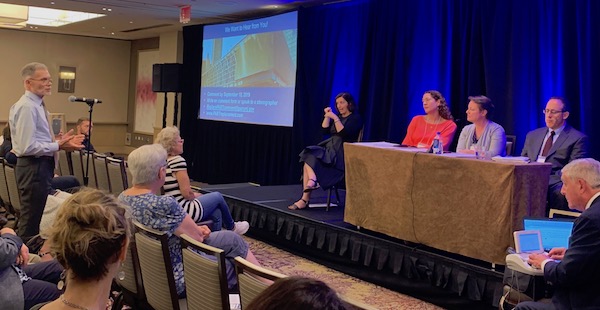
NOTE: At the end of this article, see an update.
BY KRISTEN ANCILLOTTI | The July 10 meeting held by The Port Authority of New York and New Jersey (PANYNJ) was the first step in a 120-day public outreach effort to seek formal comments from elected officials in New York and New Jersey, the City of New York, neighborhood residents, and the public, regarding plans for the Bus Terminal Replacement Project.
The meeting, at the Westin Hotel Times Square (270 W. 43rd St. btw. 7th & 8th Aves.), was one of four held on Wednesday, with two at the Westin, and two at the Clinton Inn Hotel and Events Center in Tenafly, New Jersey and launched what will likely be a series of lively comment sessions.
The proceedings began with an explanation of the rules for the day, by facilitator Maura Fitzpatrick. Public comments would be limited to four minutes, and representatives of the PANYNJ were only there to listen, and would not be responding.
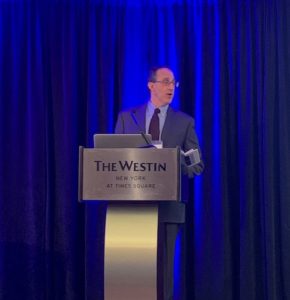
Before the floor was opened to public comment, there was a brief presentation about the potential plans for the bus terminal. Ralph D’Apuzzo, assistant director of Major Capital Programs for PANYNJ, welcomed the group.
“This planning level process is the public’s first formal opportunity to comment on the proposed project, its purpose and need, the screening of alternatives, and the approach to assessment of project alternatives,” said D’Apuzzo.
He noted that the Port Authority Bus Terminal (PABT) opened in 1950, and was expanded in 1963 and again in 1981, adding 50% more gate capacity with the addition of the north wing. Now they are considering a new replacement project for three major reasons. The first is that existing bus and passenger travel demand crossing the Hudson is expected to increase dramatically. Second, the facility is aging to the point of functional and physical obsolescence. Finally, bus storage and staging needs to be addressed.
PANYNJ’s goals include maintaining and improving connections to subways and mass transit, providing a state-of-the-art terminal, improving pedestrian accessibility, and providing direct bus links to and from the Lincoln Tunnel.
D’Apuzzo then introduced Graham Trelstad, an expert in environmental planning and community design who works on the Environmental Team with PANYNJ. Trelstad broke down how the original 13 alternatives for replacement were whittled down to three.
The three alternatives being considered at this point are to rebuild the bus terminal within all or part of the existing PABT footprint; to convert the Javits Center’s lower level for a new underground bus terminal for commuter and intercity service, and the storage and staging of buses; or to use the Javits Center’s lower level for intercity buses and the storage and staging of buses, while PABT would be rehabilitated and handle commuter service.
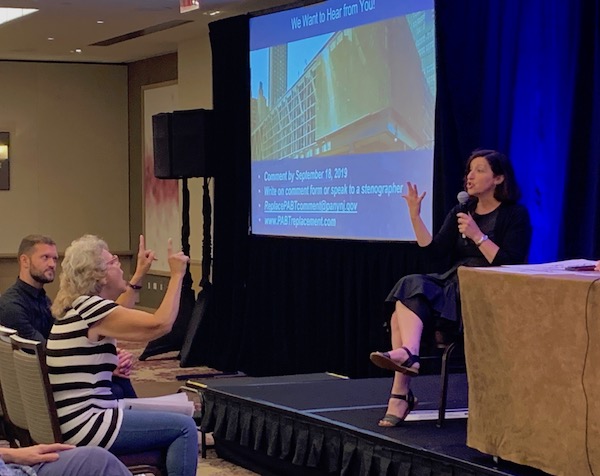
The floor was then opened for public comment, welcoming Leigh Landon, who is deaf, to start things off while a translator spoke to the crowd. Landon emphasized the need for visual communication for those who cannot hear.
“I’ve been here just over two years, almost three years, and I just started seeing in the subway signs saying when trains are coming or if there are delays,” said Landon. “Otherwise if you’re on the subway and they’re making announcements, I have no idea what’s going on. I’ll be on a train and people will start getting off and tell me to get off and I don’t know what’s happening. There’s no visual communication for me to understand, and I’m at a loss for what’s going on—and people often don’t have the time or energy to communicate with me or tell me what’s happening.”
Landon went on to explain that she wants to make sure that she has full access to all communication, particularly in the case of emergencies or important information, and that she is not the only one who would consider this a planning priority. “There are deaf people in this city and we do need to have ways to access information visually in order to have equal access and full communication for everybody,” she said. “If there’s no full access or communication, it’s really discrimination against deaf people.”
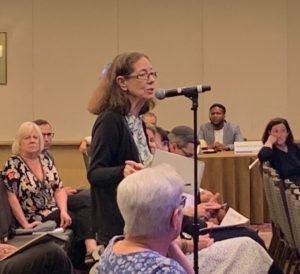
Trina Semorile, a resident of Hell’s Kitchen, was pleased to see there were multiple meetings happening, but would like to see even more, as well as a more in-depth presentation of what people should expect from the alternatives offered. She has multiple reservations about the replacement plans, including additional high-rise buildings adding to wind tunnels at street level, potential profiteering by private developers, and what she views as the attempted erasure of her neighborhood.
“If you want to build something, build it with public money,” said Semorile. “Don’t build private developments on public lands. Don’t sell off our public lands to private developers. They have destroyed a good portion of New York City by turning it into gentrified, mollified, neutralized non-neighborhoods. I personally resent the use of the term Midtown West and West Midtown in your literature. We are Hell’s Kitchen. We’ve lived here for a long time and I want you to stop doing that in your literature, and I want you to stop doing it when you talk to anybody about us. You make us invisible as a neighborhood. You make the people who live here invisible.”
Carolyn Grossman Meagher, the regional planning director at New York City Planning, read comments on behalf of Mayor Bill de Blasio’s administration. The comments pointed out the urgent need for multiple regional strategies to address the growing number of commuters from across the Hudson River, as the ability to draw workers from across the city and region has contributed to New York City’s success, according to de Blasio.
De Blasio recognizes the enormity of the project, and expressed desires for Port Authority to plan for all intercity buses, not just those currently housed in the terminals; to ensure no additional harm to air quality; and to work with city and local stakeholders to create a terminal more appropriate for a “global gateway.”

Some comments leaned more towards one option over another. Julia Campanelli, representing the newly formed HKHY Block Association (which incorporates W. 33rd through W. 35th Sts. btw. 8th & 10th Aves.), asked that they choose the option to build in the current PABT location, as the Javits Center area has become extremely crowded.
“Hudson Yards also will have 40,000 new employees, 4,000 residential units, over two million visitors per year—all of which will increase the amount of traffic in that area,” said Campanelli. “Adjacent to the Javits Center is a BoltBus stop, which also creates a large amount of traffic. The air quality and the noise quality in our community right now has decreased so much in the last four years, due to the Hudson Yards construction. Adding a bus stop there for Port Authority in the lower levels of the Javits Center would destroy our community.”
Tom Wright, from the Regional Plan Association (RPA), followed this comment by saying he was pleased that the option developed by the RPA to split operations between the Javits Center and the PABT was still in the running, and asked that all three options be given equal consideration, because building a second terminal may create additional capacity.
“Growth across the Hudson River has grown dramatically over the last generation and is projected to continue, and we have a system today that is strained in every part—cars, ferries, subway transit, commuter rail—and the bus is a critical piece of it and so we need to solve this and sort this out,” said Wright.
New Jersey resident Allen Kratz of Hoboken spoke of his reliance on the PABT. “I depend on the Port Authority Bus Terminal,” said Kratz. “It’s important for me to get to work, to go to church on Sunday morning, and to go to the movies on Saturday night.”
Kratz went on to say that he thinks the bus terminal should be built in place, adjacent to existing subways, and that he likes the idea of intercity buses arriving in a weather-protected area rather than the street.
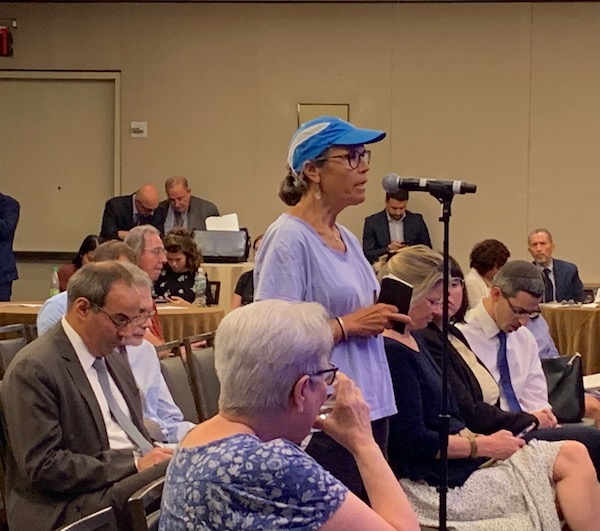
Finally, 30-year Hell’s Kitchen resident Cathleen McGuire spoke of fears that the construction would be endless, and result in more high-rise buildings not in keeping with the neighborhood.
“I love the idea of a new, redesigned—brand new actually—tear that down, that monstrosity—a new bus terminal. It’s an excellent idea, but to scale. To scale for our neighborhoods, not another ugly glass high-rise that we have to look at,” she said. “I think if we take a hint from Jane Jacobs and have a wonderful new bus facility that is in keeping with our low-rise Hell’s Kitchen neighborhood.”
McGuire’s final comment, which became the concluding comment for the meeting, focused on the effect of these changes on one specific group, which brought the conversation back to what these public meetings are all about: people.
“I’m also concerned about the people who currently on some level occupy that whole Port Authority area, and I’m talking about the homeless,” said McGuire. “I’m wondering if in your plan there is something where those people are going to be resituated—something that’s humane. And I will end on that word: humane. Keep this humane.”
If you would like to make your comments known, you can attend one of the project scoping meetings that will be held over the next several months in New York and New Jersey. More meetings will be held on Sep. 5, and comments will be taken through Sept. 18. You can also submit comments through a comment form found at www.pabtreplacement.com, or email ReplacePABTcomment@panynj.gov.
There will be a discussion of the Preliminary Draft Environmental Impact Statement Scope for Port Authority Bus Terminal at the Housing, Health & Human Services Committee meeting of CB4 on Mon., July 15, 5:30pm, at the Hudson Guild Elliot Center (441 W. 26th St. btw. 9th & 10th Aves.), in Dan Carpenter Rooms A/B.
UPDATE: On July 15, the Preliminary Draft Environmental Impact Statement Scope for Port Authority Bus Terminal (PABT) was discussed at the Housing, Health & Human Services Committee meeting of Community Board 4 (CB4), at the Hudson Guild Elliot Center (441 W. 26th St. btw. 9th & 10th Aves.).
Christine Berthet, co-chair of the Transportation Planning Committee of CB4, discussed the current stance of CB4 in a phone interview the following day. Berthet explained that, at the moment, none of the PABT plans are final, and an official position will be put out by CB4 in September, after they have had time to get comments from everyone and have a full board vote. In the meantime, the board has sent a number of statements to Port Authority over the past few months regarding their three positions on the matter.
“One is, whatever plan they have, we would prefer if it was in place because we would prefer the solution that does not take away building and residential and other historical buildings in the districts, so that’s the first point,” said Berthet. “However, we need for this plan to be able to absorb all the buses which are in the streets, and that includes the long-distance buses so that we don’t have stops all over the neighborhood; and that includes charter and parking for buses which are all along our curbs. That is an absolute top requirement for us.”
Continued Berthet: “The second requirement is that they improve air quality, and that implies multiple things, and one of them is that whenever they build a garage or they build a building, it would be enclosed and have ventilation and filtration, so that when the buses are going back and forth and idling and waiting and queuing, they do not spew their bad air in our neighborhood, because we have the third worst air quality in the city.”
As part of the air quality issue, another consideration will be how to reduce idling by cars that may potentially be backed up due to more buses being in the tunnel.
Finally, Berthet pointed out that when the Port Authority created the Lincoln Tunnel, they cut through the middle of the neighborhood, creating Dyer Ave. “I think it’s very critical that they re-cover those cuts and re-stitch the neighborhood together and create greenspace,” she said. “So that’s the third requirement, is that they create sufficient greenspace to help the community and the neighborhood to heal after all these years of, really, an open wound.”
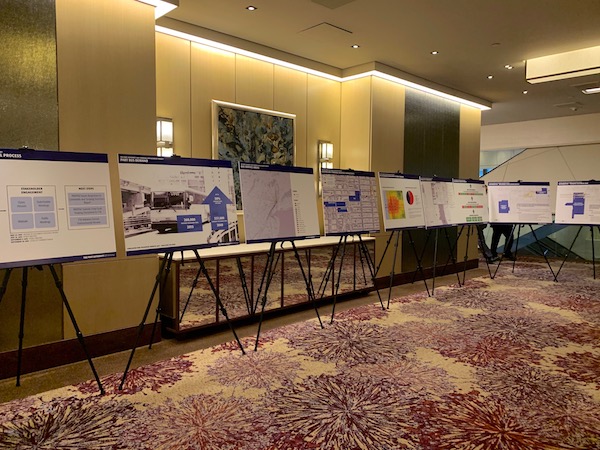
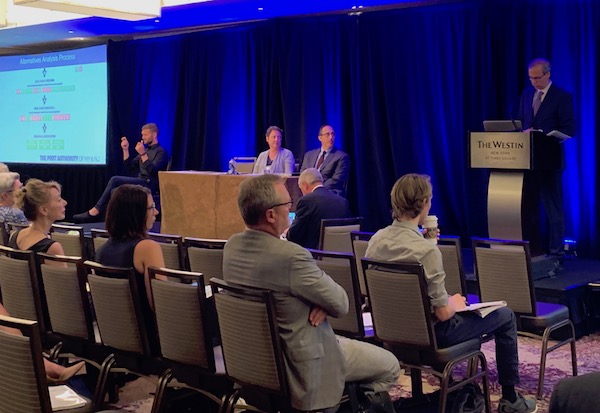
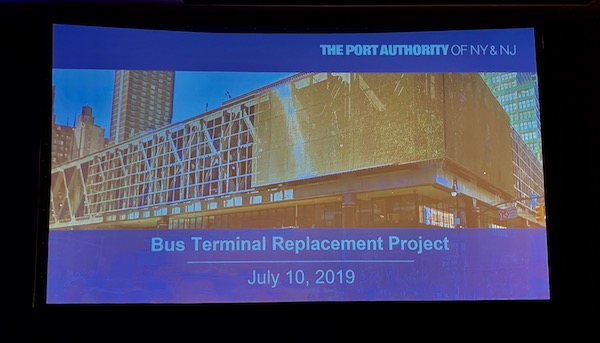
Chelsea Community News is made possible with the help of our awesome advertisers, and the support of our readers. If you like what you see, please consider taking part in our GoFundMe campaign (click here). To make a direct donation, give feedback about the site, or send a Letter to The Editor, email us at Scott@chelseacommunitynews.com.

Pingback: jazz instrumental
Pingback: spring sunset
Pingback: jazz for study
Pingback: bossa nova jazz piano
Pingback: morning music
Pingback: bossa nova music
Pingback: work jazz
Pingback: romance venice coffee shop
Pingback: soothing piano
Pingback: jazz coffee
Pingback: healing meditation
Pingback: piano jazz music
Pingback: soothing relaxation
Pingback: jazz bossa nova
Pingback: relaxing jazz coffee shop
Pingback: bossa nova jazz
Pingback: smooth jazz
Pingback: smooth jazz instrumental music
Pingback: coffee shop jazz
Pingback: outdoor coffee shop
Pingback: relaxing jazz music
Pingback: coffee shop ambience
Pingback: music for work
Pingback: jazz piano
Pingback: relaxing bossa nova
Pingback: relaxing jazz
Pingback: cozy winter
Pingback: jazz relaxing music
Pingback: jazz instrumental music
Pingback: healing therapy
Pingback: calm music
Pingback: snowfall
Pingback: meditation music
Pingback: coffee music
Pingback: piano
Pingback: relaxing music
Pingback: piano music
Pingback: relaxing winter jazz coffee shop
Pingback: night jazz
Pingback: christmas ambience
Pingback: birds chirping
Pingback: relaxing asian music
Pingback: cozy winter jazz
Pingback: focus jazz
Pingback: sleeping music
Pingback: water sounds 24/7
Pingback: jazz music definition
Pingback: musica de academia
Pingback: harp relaxing music
Pingback: tender piano jazz
Pingback: best gangster rap
Pingback: gym music
Pingback: sleep meditation
Pingback: jazz music
Pingback: gym motivation
Pingback: harp background
Pingback: happy bossa nova piano
Pingback: sleep music
Pingback: beautiful relaxing
Pingback: top gym motivation
Pingback: cozy cafe
Pingback: bonanza178
Pingback: happy jazz
Pingback: cafe bossa nova
Pingback: workout playlist
Pingback: rap music
Pingback: spa music
Pingback: type beat japanese
Pingback: jazz music meaning
Pingback: yoga music
Pingback: trap
Pingback: bossa nova
Pingback: musicas de academia
Pingback: peaceful music
Pingback: gym songs
Pingback: melhores músicas de hip hop para treinar
Pingback: workout
Pingback: exquisite autumn jazz coffee music
Pingback: cozy jazz
Pingback: calming music
Pingback: better sleep
Pingback: jazz
Pingback: cafe
Pingback: surf music cafe
Pingback: relax music
Pingback: best workout music
Pingback: relaxing sleep music
Pingback: water sounds
Pingback: deep sleep
Pingback: workout music
Pingback: background jazz
Pingback: japanese type beat 2023
Pingback: relaxing music sleep
Pingback: coffee shop music
Pingback: seaside cafe ambience
Pingback: cafe jazz
Pingback: bossa nova piano
Pingback: asmr morning
Pingback: healing music
Pingback: jazz ambience
Pingback: relaxing
Pingback: gangster trap
Pingback: beach cafe
Pingback: Meditation
Pingback: relaxing piano music
Pingback: https://www.advantageja.eu/supplements/phenq-reviews-know-ingredients-pros/
Pingback: ป้ายบิลบอร์ด
Pingback: relaxing sleep music
Pingback: join the illuminati
Pingback: Ventilatie cu tiraj fortat – sistem colectiv
Pingback: DMT Vape Pens For Sale Melbourne
Pingback: magic mushroom chocolate bar lyt
Pingback: More Info
Pingback: m.ytmp3.bz
Pingback: magic mushroom dispensary
Pingback: morphine kaufen
Pingback: สำนักงานบัญชี เชียงใหม่
Pingback: sbo
Pingback: พิโกไฟแนนซ์
Pingback: Köp Methadone Online
Pingback: Outsourcing DevOps efforts
Pingback: sbo
Pingback: สล็อตวอเลท
Pingback: relx
Pingback: Fire arms for sale online
Pingback: click reference
Pingback: mortgage
Pingback: dumps 201 with pin
Pingback: kurumsal sunucu yapılandırma